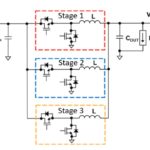Power supplies from phone chargers to EVs to industrial machinery rely on semiconductors, either in discrete packages or integrated into power modules, to deliver power. APEC 2024 was full of power sources and components. The roundup below highlights regulators, switches, and power semiconductors. We also highlight wireless power delivery and chargers. Be sure to see […]
Point of Load
APEC 2024: Power to the data center
Data centers power the world, or does the world power data centers? According to one report, datacenters currently consume 2% of the world’s electricity and that could increase to 8% by 2030. Much of that electricity arrives at the load as low voltage, high current. For example, a single IC, processor, graphics processor, AI chip, […]
Point-of-Load converters packaged in SIP or horizontal-mount format
Flex Power Modules has announced that its BMR473 digital Point-of-Load converter is packaged in a space-saving SIP or horizontal-mount format. The product is rated at 40 A continuous and up to four can be paralleled for up to 160 A, with synchronization and phase spreading for minimum EMI. Excellent thermal performance, a custom inductor design, […]
Optimizing power delivery networks
A few rules of thumb help navigate the nuances and common pitfalls of power system design using power modules. Jeff Ham, Vicor Corp. With industry emphasis on minimizing and eliminating waste wherever possible, it is the responsibility of the system designer to optimize the overall power architecture. Every piece of electronic equipment has a power […]
What’s a voltage regulator module?
A voltage regulator module (VRM) is a specialized point-of-load (PoL) power converter, sometimes called a processor power module (PPM). Like other PoLs, VRMs are buck converters. They are specifically designed to convert a 5V or 12V bus to a specific voltage needed to power a central processing unit (CPU) or graphics processing unit (GPU) in […]
What are Point-of-Load converters?
Point-of-load converters (PoLs) are used in distributed power architectures (DPAs) to step down a relatively high power distribution bus voltage to the lower voltages needed by system components such as microprocessors, ASICs, and other digital ICs. DPAs are used in systems of all sizes to improve power distribution efficiency. Larger systems tend to use higher […]







